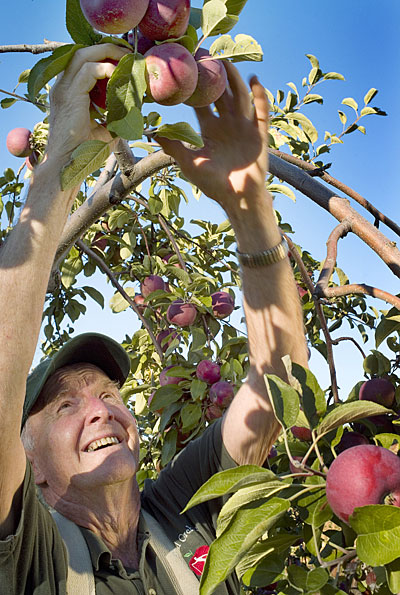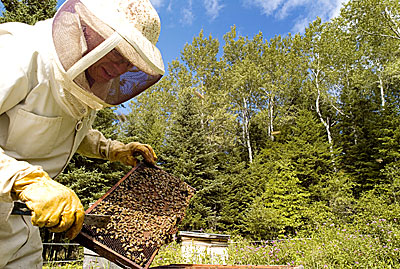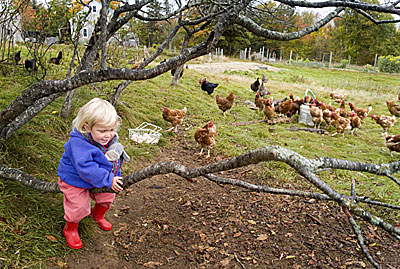 |
| McDougal Orchard in Sanford is one of three farms that Maine Farmland Trust has helped protect. Bridget Besaw photo. |
by John Piotti
When I give presentations on farming in Maine, I usually begin with this true-or-false quiz:
• In the last two federal agricultural censuses, the number of farmers in Maine increased.
• In the same period, the amount of Maine farmland in production increased.
• Maine has the fifth youngest farmer population in the nation.
All three statements are true. Yet in an audience of, say, 50, I may see only a half-dozen hands raised, if that. Many people think farming in Maine is dead.
`
The truth is very different. Over the past 15 years, Maine has made steady progress in increasing the number of small farms that serve local markets, thanks to MOFGA in no small part. Of course, Maine also lost farms during this period, mostly farms that served commodity markets (in dairy, potatoes or apples), but new growth compensates for the losses.
Now consider the recent attention being paid to local food, as brought about by mounting safety concerns, rising oil prices, and popular books such as The Omnivore’s Dilemma and Animal, Vegetable, Miracle. Future demand for local farm products will only increase. That’s the good news.
The bleak news, though, threatens all of the progress of the past 15 years.
There is a reason why so many people think farming is dying: They have seen so much local farmland converted into house lots and shopping plazas. Though highly visible, little of this conversion has occurred on Maine’s best farmland, which has remained relatively stable at about 1.2 million acres. That could now change.
Russell Libby, MOFGA’s executive director and one of the founders of Maine Farmland Trust, estimates that within the next 10 to 15 years, as much as one-third of Maine’s best farmland (up to 400,000 acres) will be in transition as aging farmland owners sell or die. (Though Maine boasts many young farmers, much of our farmland is owned by elderly persons.) A good portion of that land will not be sold to farmers, unless it can be preserved first.
 |
| The Miller Farm in Westmanland is another farm protected by the Maine Farmland Trust. Bridget Besaw photo. |
When preserved farmland ultimately changes hands, it sells at its value as farmland, not as house lots, making it affordable for farming. Preserving more farmland will allow more prospective farmers to begin new enterprises and will help existing farmers expand operations or secure land that they currently lease.
Thus, preserving farmland is critical to preserving farming.
This may sound obvious, but it wasn’t regarded as such within Maine’s farming community until recently. For many years, the whole focus was on making farms profitable, under the belief that if a farm is profitable, everything else takes care of itself. This is logical, to a point, and that point is the day the farm changes hands. The next day the same farm could be growing the same crops and selling to the same markets, but if the new farmland owner needs to pay off a large mortgage (because he had to pay what a developer would for the property), the farm may no longer be economically viable.
Such concerns led to creation in 1999 of Maine Farmland Trust. Since then, this organization, which I direct, has preserved over 13,000 acres of farmland, or 65% of all the preserved farmland in Maine. We also run Maine FarmLink, which has helped ensure that another 32 farms – over 3,000 additional acres – remain working.
Though proud of these accomplishments, we realize that the challenge before us demands far more. To preserve farmland at the scale that’s needed (i.e., a few hundred thousand acres in the next decade) requires a whole new level of activity.
In response to this challenge, Maine Farmland Trust has begun expanding existing programs and creating new ones (such as “Buy/Protect/Sell,” which allows us to buy vulnerable farmland, preserve it, and re-sell it to new farmers). As a result, we’ve preserved more land in the past year than in the previous eight years combined!
 |
| Quill’s End Farm in Penobscot is protected by the Maine Farmland Trust. Bridget Besaw photo. |
The key to this expansion is building our member base. We’ve been able to double membership in each of the past two years (from 400 to over 1,600 households). But to keep on pace, we need to double again this coming year. You can join at www.mainefarmlandtrust.org
Maine isn’t losing farmland because farming doesn’t have a future, but because our current economic system favors development on farmland, despite how shortsighted that is. Maine is going to want that farmland someday. Our prosperity and perhaps our survival will depend on it.
I’m convinced that at some point in the future, our economic system will reflect real values and real costs. At that point, we won’t need to take steps to preserve farmland, because such land will be valued as the precious resource it is. Until that happens, Maine Farmland Trust has much work to do.
John Piotti is executive director of Maine Farmland Trust and a member of Maine’s Legislature. He has contributed to the fields of sustainable agriculture and community development for 20 years, in Maine and nationally. In 2005, he was one of only eight Americans to receive a prestigious Eisenhower Fellowship.
